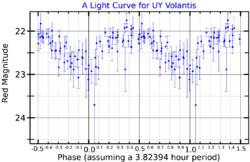Astronomy:UY Volantis
| Observation data Equinox J2000.0]] (ICRS) | |
|---|---|
| Constellation | Volans |
| Right ascension | 07h 48m 33.71s[2] |
| Declination | −67° 45′ 07.70″[2] |
| Apparent magnitude (V) | 16.9[3] |
| Characteristics | |
| Apparent magnitude (U) | 16.10[3] |
| Apparent magnitude (B) | 17[3] |
| Apparent magnitude (R) | 16.7[2] |
| Astrometry | |
| Radial velocity (Rv) | 20[4] km/s |
| Distance | 6,800 - 9,100[5] pc |
| Other designations | |
EXO 0748-676 | |
| Database references | |
| SIMBAD | data |
UY Volantis, also known as EXO 0748-676, is a low mass X-ray binary[6] system located in the constellation Volans. With an apparent magnitude of 16.9, it requires a powerful telescope to see. With a radial velocity of 20 km/s, it is drifting away from the Solar System, and is currently located 26,000 light years away.
Properties
The properties of the two system components are uncertain and contradictory. One component is almost certain to be a neutron star, which has a fairly strict upper mass limit. The other component is a low mass star, but its properties are affected by the close neutron star. The two components orbit each other every 3.82 hours.[7]
The system undergoes x-ray eclipses which can be used to constrain the properties of the orbit and of the component stars. The orbital inclination must be high and is thought to be about 76°.[8] The mass ratio of the components is relatively well-known and shows the neutron star to be about four times as massive as its partner. This implies either an unusually low-mass star or an unusually high-mass neutron star. Simple models produce neutron star masses above 3 M☉ which is theoretically impossible.[9] More complex models of the system produced by measuring the eclipses still produce an unexpectedly high neutron star mass of about 2 M☉ which would make it one of the highest known.[8] A more expected neutron star mass of around 1.4 M☉ can be deduced by making certain assumptions about the origin of the spectral lines or an unusually low-mass companion.[10][8]
References
- ↑ Hynes, Robert I.; Jones, Erica D. (2009). "The Quiescent Optical and Infrared Counterpart to EXO 0748-676 = UY Vol". The Astrophysical Journal 697 (1): L14–L17. doi:10.1088/0004-637X/697/1/L14. Bibcode: 2009ApJ...697L..14H.
- ↑ 2.0 2.1 2.2 Monet, David G. et al. (February 2003). "The USNO-B Catalog". The Astronomical Journal 125 (2): 984–993. doi:10.1086/345888. ISSN 0004-6256. Bibcode: 2003AJ....125..984M.
- ↑ 3.0 3.1 3.2 Liu, Q. Z.; van Paradijs, J.; van den Heuvel, E. P. J. (11 April 2007). "A catalogue of low-mass X-ray binaries in the Galaxy, LMC, and SMC (Fourth edition)". Astronomy & Astrophysics 469 (2): 807–810. doi:10.1051/0004-6361:20077303. ISSN 0004-6361. Bibcode: 2007A&A...469..807L.
- ↑ Duflot, M.; Figon, P.; Meyssonnier, N. (1995-12-01). "Vitesses radiales. Catalogue WEB: Wilson Evans Batten. Subtittle: Radial velocities: The Wilson-Evans-Batten catalogue.". Astronomy and Astrophysics Supplement Series 114: 269. ISSN 0365-0138. Bibcode: 1995A&AS..114..269D.
- ↑ Jonker, P. G.; Nelemans, G. (October 2004). "The distances to Galactic low-mass X-ray binaries: consequences for black hole luminosities and kicks". Monthly Notices of the Royal Astronomical Society 354 (2): 355–366. doi:10.1111/j.1365-2966.2004.08193.x. ISSN 0035-8711. Bibcode: 2004MNRAS.354..355J.
- ↑ Baumgartner, W. H.; Tueller, J.; Markwardt, C. B.; Skinner, G. K.; Barthelmy, S.; Mushotzky, R. F.; Evans, P. A.; Gehrels, N. (5 July 2013). "THE 70 Month SWIFT--BAT All-sky Hard X-Ray Survey". The Astrophysical Journal Supplement Series 207 (2): 19. doi:10.1088/0067-0049/207/2/19. ISSN 0067-0049. Bibcode: 2013ApJS..207...19B.
- ↑ Ritter, H.; Kolb, U. (2003-06-01). "Catalogue of cataclysmic binaries, low-mass X-ray binaries and related objects (Seventh edition)". Astronomy and Astrophysics 404: 301–303. doi:10.1051/0004-6361:20030330. ISSN 0004-6361. Bibcode: 2003A&A...404..301R.
- ↑ 8.0 8.1 8.2 Knight, Amy H.; Ingram, Adam; Middleton, Matthew; Drake, Jeremy (2022). "Eclipse mapping of EXO 0748-676: Evidence for a massive neutron star". Monthly Notices of the Royal Astronomical Society 510 (4): 4736. doi:10.1093/mnras/stab3722. Bibcode: 2022MNRAS.510.4736K.
- ↑ Ratti, E. M.; Steeghs, D. T. H.; Jonker, P. G.; Torres, M. A. P.; Bassa, C. G.; Verbunt, F. (2012). "Optical spectroscopy of the quiescent counterpart to EXO 0748-676: A black widow scenario?". Monthly Notices of the Royal Astronomical Society 420 (1): 75. doi:10.1111/j.1365-2966.2011.19999.x. Bibcode: 2012MNRAS.420...75R.
- ↑ Mikles, Valerie J.; Hynes, Robert I. (2012). "Gemini Multi-Object Spectrograph Spectroscopy of EXO 0748-676 (=UY Vol) in Outburst". The Astrophysical Journal 750 (2): 132. doi:10.1088/0004-637X/750/2/132. Bibcode: 2012ApJ...750..132M.
 |


